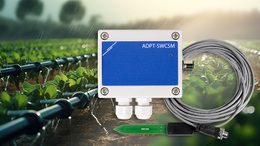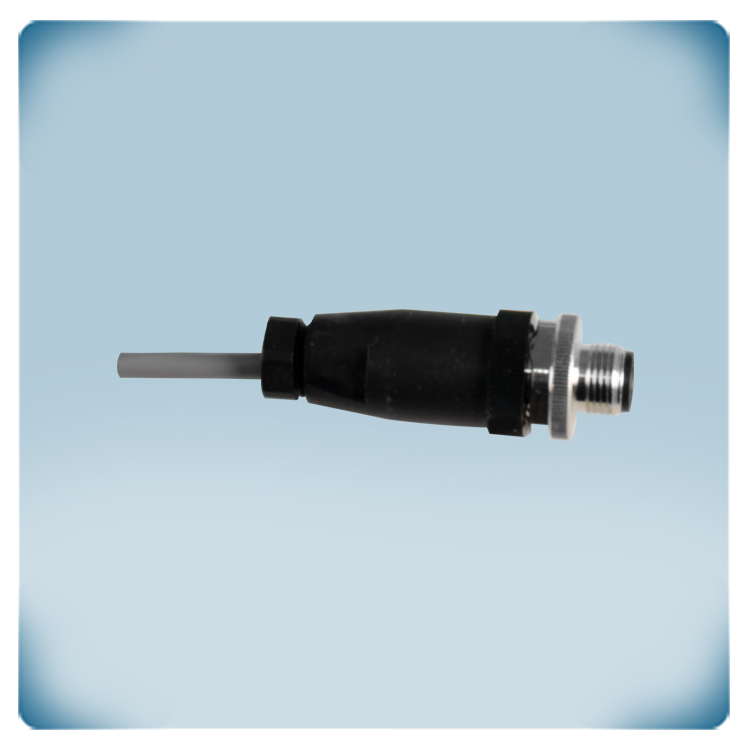EU declaration conformity
Soil moisture sensor
Product description
This soil moisture sensor measures the soil water content.
It is typically applied in agricultural settings to avoid overwatering. The supply voltage is 24 VDC. Modbus RTU communication is used to access all measurements.
The electronics of the sensor is enclosed in a rubber sealing. The integrated cable is 7,5 metres long. To connect this sensor to a Sentera PoM network, a unique adaptor box type ADPT-SWCSM is needed.
Documents
Additional specifications and description
The amount of water in the soil
For the growth of top-notch plants, a healthy soil moisture and water balance must be maintained. Plants in dry soil stunt and wilt due to nutrient deficiencies. Plants grow less resistant to dry conditions later in their life cycles and are more susceptible to disease pressure in wet soil. The plant will become suffocated and die from excessive watering. Agrichemicals are less likely to leach when irrigation is done effectively.
How does it function?
This soil moisture sensor combines capacitance and frequency domain reflectometry (FDR) technology to determine the volumetric water content of the soil. FDR sensors measure the amount of time it takes for an electromagnetic pulse to reflect back to the sensor after traveling through the soil. Our sensor transmits an electromagnetic signal through a metal tine using an oscillator (other wave guides are also feasible). To gauge soil moisture, the difference in frequency between the output wave and the return wave is measured. These sensors offer information on the water content of the soil and the water status of the plants when installed and used properly.
In order to accurately track the moisture of the field, the sensor should be placed in the effective root zone and at strategic locations. It's crucial to have good contact between the green sensor component and the ground. Don't completely bury the sensor in the earth. Installing multiple sensors offers fresh perspectives on how rainwater seeps into the soil. It is frequently used to look into how effective irrigation is.
Water is a precious resource. It is possible to manage irrigation and conserve water by measuring the water content of the soil.
Installation
If the sensor is installed close to the surface, keeping the mould and cable above the soil surface, the sensor can sometimes be pushed directly into the soil. Do not hit the sensor with a hammer or other blunt object as this may damage the sensor's electronics. If the soil is very hard, a small slit can be dug into the ground with a knife or shovel to facilitate insertion. Make sure there is sufficient contact between the soil and the sensor and that there is as little air around the sensor element as possible. Do not place the SWCSM near metal objects. This may disturb the electromagnetic field of the sensor and the readings may change as a result. The sensor enclosure offers an IP65 protection class.
How to connect?
The integrated cable on this soil moisture sensor is 7,5 meters long. To connect this sensor to a Sentera Modbus network, an adaptor box of type ADPT-SWCSM is needed. The sensor requires a 24 V DC power supply. The measurements can be read out via Modbus RTU communication.
For the growth of top-notch plants, a healthy soil moisture and water balance must be maintained. Plants in dry soil stunt and wilt due to nutrient deficiencies. Plants grow less resistant to dry conditions later in their life cycles and are more susceptible to disease pressure in wet soil. The plant will become suffocated and die from excessive watering. Agrichemicals are less likely to leach when irrigation is done effectively.
How does it function?
This soil moisture sensor combines capacitance and frequency domain reflectometry (FDR) technology to determine the volumetric water content of the soil. FDR sensors measure the amount of time it takes for an electromagnetic pulse to reflect back to the sensor after traveling through the soil. Our sensor transmits an electromagnetic signal through a metal tine using an oscillator (other wave guides are also feasible). To gauge soil moisture, the difference in frequency between the output wave and the return wave is measured. These sensors offer information on the water content of the soil and the water status of the plants when installed and used properly.
In order to accurately track the moisture of the field, the sensor should be placed in the effective root zone and at strategic locations. It's crucial to have good contact between the green sensor component and the ground. Don't completely bury the sensor in the earth. Installing multiple sensors offers fresh perspectives on how rainwater seeps into the soil. It is frequently used to look into how effective irrigation is.

Water is a precious resource. It is possible to manage irrigation and conserve water by measuring the water content of the soil.
Installation
If the sensor is installed close to the surface, keeping the mould and cable above the soil surface, the sensor can sometimes be pushed directly into the soil. Do not hit the sensor with a hammer or other blunt object as this may damage the sensor's electronics. If the soil is very hard, a small slit can be dug into the ground with a knife or shovel to facilitate insertion. Make sure there is sufficient contact between the soil and the sensor and that there is as little air around the sensor element as possible. Do not place the SWCSM near metal objects. This may disturb the electromagnetic field of the sensor and the readings may change as a result. The sensor enclosure offers an IP65 protection class.
How to connect?
The integrated cable on this soil moisture sensor is 7,5 meters long. To connect this sensor to a Sentera Modbus network, an adaptor box of type ADPT-SWCSM is needed. The sensor requires a 24 V DC power supply. The measurements can be read out via Modbus RTU communication.




.webp)
.webp)
.webp)



Remarks, reviews & ratings